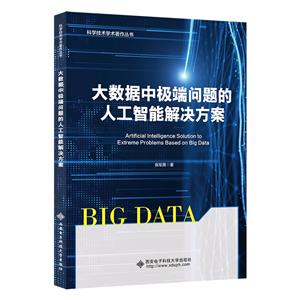-
>
全国计算机等级考试最新真考题库模拟考场及详解·二级MSOffice高级应用
-
>
决战行测5000题(言语理解与表达)
-
>
软件性能测试.分析与调优实践之路
-
>
第一行代码Android
-
>
JAVA持续交付
-
>
EXCEL最强教科书(完全版)(全彩印刷)
-
>
深度学习
大数据中极端问题的人工智能解决方案 版权信息
- ISBN:9787560670928
- 条形码:9787560670928 ; 978-7-5606-7092-8
- 装帧:平装-胶订
- 册数:暂无
- 重量:暂无
- 所属分类:>
大数据中极端问题的人工智能解决方案 内容简介
Machine learning, as the most important technology and tool in artificial intelligence, has been successfully applied in solving various complex problems. After a brief introduction to the basic methods and algorithms of machine learning, this book collects artificial intelligence solutions for typical complex problems of wide range, such as handwritten digit recognition, radar automatic target recognition, computer-aided disease diagnosis, image filtering for images contaminated with heavy noises, gene expression heterogeneity correction, preeclampsia risk prediction, and some typical combinatorial optimization problems such as multi-constraint shortest path problem, traveling salesman problem, and so forth. The aim is to examine, through these cases, how to use machine learning technology to create effective methods and algorithms for solving complex problems, and which reveals enormous advantages and severe challenges of artificial intelligence technology.Machine learning, as the most important technology and tool in artificial intelligence, has been successfully applied in solving various complex problems. After a brief introduction to the basic methods and algorithms of machine learning, this book collects artificial intelligence solutions for typical complex problems of wide range, such as handwritten digit recognition, radar automatic target recognition, computer-aided disease diagnosis, image filtering for images contaminated with heavy noises, gene expression heterogeneity correction, preeclampsia risk prediction, and some typical combinatorial optimization problems such as multi-constraint shortest path problem, traveling salesman problem, and so forth. The aim is to examine, through these cases, how to use machine learning technology to create effective methods and algorithms for solving complex problems, and which reveals enormous advantages and severe challenges of artificial intelligence technology.
This book can serve as the textbook for undergraduates, graduate students and PhD students for related courses about machine learning and a reference for their research work in the majors of Computer Science, Artificial Intelligence, Automation and so forth in colleges and universities. It can also be a reference for researchers and engineers who are interested in machine learning and artificial intelligence.
机器学习作为人工智能*重要的技术和工具,已成功应用于解决各种复杂问题。本书在简略介绍机器学习的基本方法与算法的基础上,通过搜集典型复杂问题的人工智能解决方案,诸如手写数字识别、雷达自动目标识别、癌症诊断、超强噪声污染情况下的图像过滤、基因芯片异质性校正、孕妇子痫前期风险预测,以及一些典型的组合优化问题,如多约束*短路径问题和旅行商问题等,考察如何运用机器学习技术,创造解决复杂问题的有效方法和算法,并通过这些案例窥视出人工智能技术的巨大优势和其面临的极其严峻的挑战。
本书可作为本科生、研究生和博士生学习机器学习相关课程的教材,也可供高校计算机科学、人工智能、自动化等专业技术人员,以及对机器学习、人工智能感兴趣的研究人员和工程师参考。
大数据中极端问题的人工智能解决方案 目录
- >
自卑与超越
自卑与超越
¥13.7¥39.8 - >
史学评论
史学评论
¥14.4¥42.0 - >
月亮与六便士
月亮与六便士
¥19.1¥42.0 - >
上帝之肋:男人的真实旅程
上帝之肋:男人的真实旅程
¥20.2¥35.0 - >
名家带你读鲁迅:朝花夕拾
名家带你读鲁迅:朝花夕拾
¥10.5¥21.0 - >
伯纳黛特,你要去哪(2021新版)
伯纳黛特,你要去哪(2021新版)
¥16.9¥49.8 - >
我从未如此眷恋人间
我从未如此眷恋人间
¥16.9¥49.8 - >
中国人在乌苏里边疆区:历史与人类学概述
中国人在乌苏里边疆区:历史与人类学概述
¥21.6¥48.0
-
大模型应用开发极简入门 基于GPT-4和ChatGPT
¥41.9¥59.8 -
人工智能 现代方法 第4版(全2册)
¥120.8¥198 -
计算机视觉:算法与应用
¥95.9¥139 -
必然(修订版)
¥53.5¥89 -
GPT时代人类再腾飞
¥54.9¥89.9 -
生成式人工智能(AIGC)应用
¥64.9¥90
社会符号学视角下的图文互补研究
¥65.8¥108.0一年级上册:青蛙写诗/课文作家作品
¥15.7¥21.0考试达人全国护师资格考试 试题金典 2020
¥83.3¥98.0工程测量
¥27.9¥39.0Advances in Rock Dynamics(岩土动力学研究进展)
¥34.6¥42.0

















